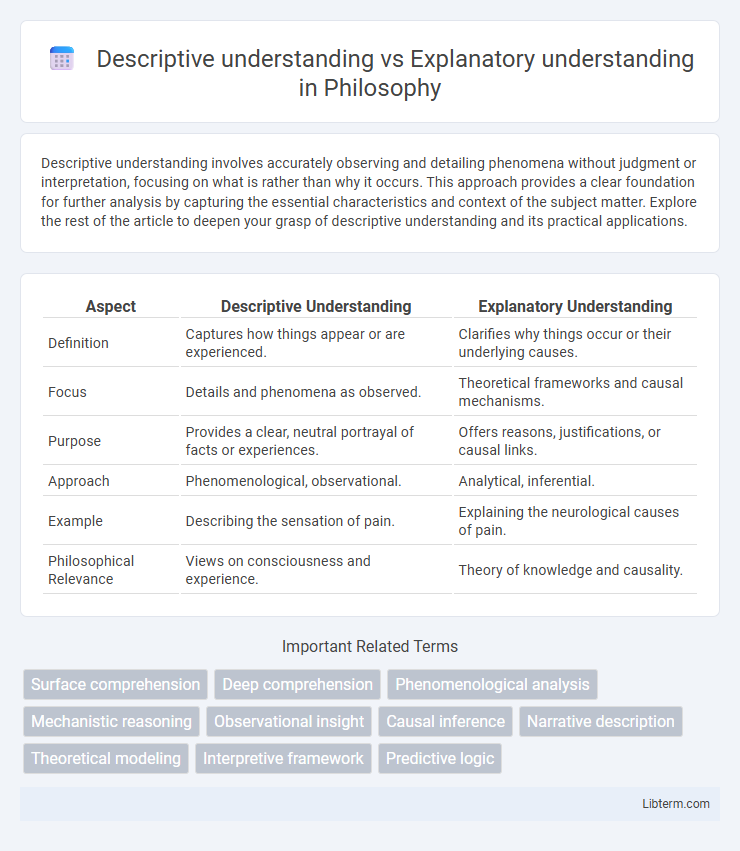Descriptive understanding involves accurately observing and detailing phenomena without judgment or interpretation, focusing on what is rather than why it occurs. This approach provides a clear foundation for further analysis by capturing the essential characteristics and context of the subject matter. Explore the rest of the article to deepen your grasp of descriptive understanding and its practical applications.
Table of Comparison
| Aspect | Descriptive Understanding | Explanatory Understanding |
|---|---|---|
| Definition | Captures how things appear or are experienced. | Clarifies why things occur or their underlying causes. |
| Focus | Details and phenomena as observed. | Theoretical frameworks and causal mechanisms. |
| Purpose | Provides a clear, neutral portrayal of facts or experiences. | Offers reasons, justifications, or causal links. |
| Approach | Phenomenological, observational. | Analytical, inferential. |
| Example | Describing the sensation of pain. | Explaining the neurological causes of pain. |
| Philosophical Relevance | Views on consciousness and experience. | Theory of knowledge and causality. |
Introduction to Understanding: Descriptive vs Explanatory
Descriptive understanding involves observing and detailing phenomena as they appear, focusing on "what" and "how" aspects without delving into causes. Explanatory understanding seeks to uncover "why" behind occurrences by identifying underlying mechanisms and causal relationships. This distinction is crucial in research, where descriptive analysis summarizes data patterns, while explanatory analysis interprets reasons and connects variables for deeper insight.
Defining Descriptive Understanding
Descriptive understanding involves capturing and detailing observable phenomena, focusing on what, when, and how something occurs without addressing the underlying causes. It emphasizes accurate representation and categorization of facts or events to provide a clear and objective account. This form of understanding forms the foundation for further analysis but does not seek to explain why the phenomena happen.
Defining Explanatory Understanding
Explanatory understanding involves grasping the causal relationships and underlying mechanisms that account for why a phenomenon occurs, going beyond merely describing its features or patterns. It requires identifying the principles, reasons, or factors that produce an event, enabling predictive power and deeper insight into the subject matter. This type of understanding is fundamental in scientific inquiry and critical thinking, as it provides a framework for interpreting evidence and generating meaningful explanations.
Key Differences Between Descriptive and Explanatory Understanding
Descriptive understanding involves identifying and detailing characteristics, patterns, or phenomena without addressing the causes, focusing on what occurs or exists. Explanatory understanding goes beyond description by uncovering underlying causes, reasons, and mechanisms that account for why events happen or conditions arise. The key difference lies in descriptive understanding's emphasis on observation and categorization, whereas explanatory understanding prioritizes causal analysis and depth of insight.
The Role of Description in Knowledge Acquisition
Descriptive understanding provides detailed observations and categorizes phenomena, serving as the foundation for knowledge acquisition by capturing the complexity of data without immediate interpretation. It enables the identification of patterns and relationships essential for developing hypotheses and guiding further inquiry. By systematically documenting what is observed, descriptive understanding facilitates the transition to explanatory understanding, where causal mechanisms and underlying principles are analyzed.
The Significance of Explanation in Scientific Inquiry
Explanatory understanding in scientific inquiry transcends mere description by revealing underlying causes and mechanisms driving observed phenomena, enabling predictive power and hypothesis testing. Descriptive understanding catalogues and characterizes details, but explanatory frameworks integrate data into coherent models that foster deeper insights and guide experimental design. The significance of explanation lies in its ability to connect empirical evidence with theoretical constructs, advancing scientific progress through causal comprehension and validation.
When to Use Descriptive Understanding
Descriptive understanding is essential when the goal is to capture and summarize observable patterns, behaviors, or phenomena without delving into causal mechanisms. This approach is most effective in initial research phases, market analysis, or user experience studies where identifying "what" is happening takes precedence over "why." Employing descriptive methods provides a clear foundation for subsequent explanatory analysis by establishing factual context and baseline knowledge.
When Explanatory Understanding is Essential
Explanatory understanding is essential when analyzing complex phenomena that require uncovering causal relationships and underlying mechanisms rather than merely describing observable patterns. In scientific research, policy-making, and problem-solving contexts, explanatory understanding enables predicting outcomes and designing effective interventions by addressing the 'why' and 'how' questions. Descriptive understanding provides foundational knowledge, but explanatory understanding drives innovation, informed decisions, and deeper insights across disciplines.
Challenges in Shifting from Description to Explanation
Shifting from descriptive understanding to explanatory understanding poses significant challenges including the need to identify causal relationships rather than mere patterns or correlations. Analysts must integrate theoretical frameworks and contextual factors to move beyond surface-level observations, which often requires advanced methodological approaches and critical reasoning skills. This transition demands overcoming biases toward oversimplification and developing the ability to interpret complex, multifaceted data in a meaningful and coherent manner.
Practical Examples: Descriptive vs Explanatory Understanding
Descriptive understanding involves observing and summarizing facts, such as noting that a patient has a fever or that sales increased by 10%. Explanatory understanding goes deeper by identifying underlying causes, like linking the fever to a specific infection or attributing sales growth to a successful marketing campaign. For example, in education, recognizing that students perform poorly on tests is descriptive, while analyzing factors such as teaching methods or study habits provides explanatory insights.
Descriptive understanding Infographic

 libterm.com
libterm.com